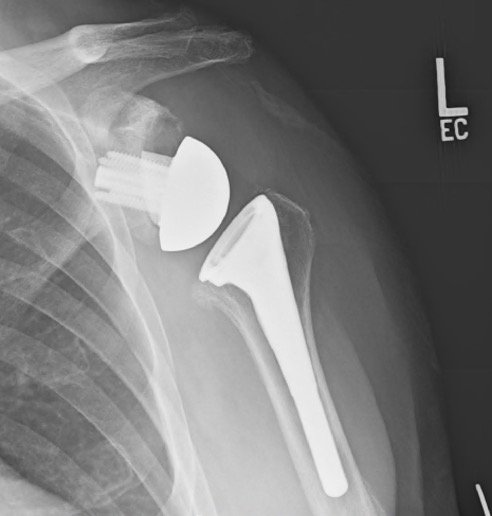Reverse Total Shoulder Arthroplasty
-
A reverse total shoulder arthroplasty (R-TSA) is a specific variation of a shoulder replacement surgery.
The shoulder joint (glenohumeral joint) is still being replaced as it would be in an anatomic total shoulder arthroplasty; however, instead of retaining the normal anatomic relationship of the ball-and-socket, the R-TSA switches/”reverses” the ball and the socket.
In other words, the replacement ball (glenosphere) now will be fixated to your shoulder socket (glenoid) and the socket (cup/humeral stem component) will be placed into the arm bone (humerus).
-
The R-TSA was designed to function as a shoulder replacement when there is non-existent or functional rotator cuff.
The biomechanics of the R-TSA changes the center of rotation (COR) for the shoulder joint to maximize use of the deltoid as the primary mover of the arm/shoulder (instead of the rotator cuff).
R-TSA is also frequently used in cases of severe deformity and bone loss as a result of advanced osteoarthritis.
-
To be a candidate for a reverse total shoulder replacement, you would likely be diagnosed with one or more of the following conditions:
Rotator cuff arthropathy — arthritis as a result of a chronically torn/absent rotator cuff.
Glenohumeral osteoarthritis — loss of cartilage in the ball-and-socket joint of the shoulder.
Irreparable or massive rotator cuff tear — a very large tear of multiple tendons of the rotator cuff or a tear pattern that does not allow for a repair.
Proximal Humerus Fracture — complex or displaced fractures of the proximal humerus (ball) can qualify as candidates.
Severe glenoid or humeral bone loss — bone loss often as a result of severe, long-term arthritis.
-
The surgery involves making an oblique 5-6cm incision over the anterior shoulder/arm.
The primary surgical plane occurs between the deltoid and pectoralis major muscles.
The biceps tendon, if still intact, is often cut and secured to the pectoralis major tendon (tenodesis).
The subscapularis is released to allow access to the shoulder joint and repaired at the end of the case, if indicated.
The arthritic surfaces of the ball and socket are removed/prepared.
A baseplate is secured with screws (4-5 in total) into the glenoid (socket) and a hemispherical ball is secured to this (glenosphere).
A humeral stem is potted into the canal of the humerus with a size based on your anatomy.
A highly cross linked polyethylene cup is secured into the humeral stem and articulates with the glenosphere.
-
The glenosphere (ball) is typically made of a cobalt-chromium alloy.
The baseplate and humeral stem are typically made of a titatium alloy.
